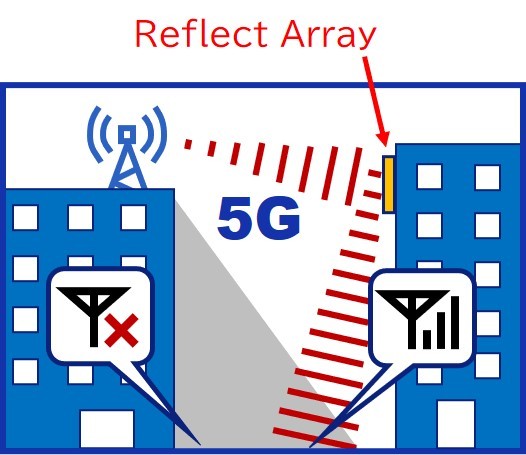DNP develops reflect arrays to improve 5G coverage
Dai Nippon Printing Co., Ltd. has developed a Reflect Array that flexibly reflects the millimetre waves used in fifth generation (5G) mobile communications systems to expand coverage area.
Compared to general metal reflectors, the new product is capable of reflecting millimetre waves in a more targeted manner. As a result, there are fewer restrictions on installation, making it possible to improve the communications environment in locations where radio waves have been difficult to reach, such as those in the shadow of buildings. In addition, the new product boasts superior design features allowing it to respond to various installation environment considerations.

Background
The 24GHz and above radio waves used in the high-speed large-capacity communications of 5G are higher frequency milliwaves than those used in 4G, and maintain a larger information capacity. At the same time, they are characterized by strong straightness properties and short reach, leading to radio waves being blocked in areas such as in the shadow of buildings making it difficult to ensure communication quality. Also, when adding base stations and relay equipment to resolve this issue, new challenges emerge, such as large costs and the difficulty of securing installation space.
DNP has once again risen to the challenge, taken advantage of proprietary microfabrication technology, and by applying an original concept has successfully separated the Frequency Selection Reflection Layer that selectively reflects predetermined frequency bands while merely passing through other radio waves, and the Reflective Direction Control Layer, a special dielectric layer that decides the direction of incoming and reflected radio waves, to develop a Reflect Array that makes it easier to control for the characteristics of each layer. The newly developed product is cheaper than installing base stations and relay equipment, and does not require a power source. It can, therefore, be installed in a variety of location, which contributes to significant improvements in the 5G communications environment.

Features
- Can be installed in a variety of locations: Unlike metal reflectors that reflect radio waves directly as in a mirror, the newly developed product is a reflective array capable of the asymmetric reflection of specific frequency radio waves. It is possible to flexibly set the frequency band to be reflected, the incidence angle of the radio waves received from the base station, and the reflection angle to deliver the radio waves, along with the spread of the reflection waves. As a result, it is now possible to effectively deliver radio waves to locations where it was previously difficult to do so. As a power source is no longer needed the new product can also be used in locations where installation space is restricted.
- Effective designs based on original concepts: The new product is comprised of three layers: the Frequency Selective Surface Layer that selectively reflects predetermined frequency bands while merely passing through other radio waves, the Reflective Direction Control Layer that decides the direction of incoming and reflected radio waves, and a Design Cover Layer that not only protects these two layers, but also provides the durability required of construction materials along with high level design features that are conducive to various installation environment considerations.
- Effective improvement of radio wave conditions: We have made it is possible to pre-adjust the spread of the reflection waves in answer to the desire to deliver reflection waves over a broad area, or to gather those waves into specific devices.
- Reduces the impact on existing radio waves: Unlike metal reflectors that reflect all radio waves, the new product passes through all but target radio waves, reducing the impact on existing radio waves.
- Superior design features: It is possible to print various patterns on the surface of the Design Cover Layer, making it possible to add external designs, including interior, exterior and advertising signboards.

Usage
Recently, we have seen more companies and organizations consider the adoption of 5G as a means of targeting the realization of smart cities and smart factories that exploit robots and the Internet of Things (IoT). Commercialization efforts are already underway. With the development of the Reflect Array, we anticipate the following installation instances in cases where the radio wave environment is expected to deteriorate due to obstacles, and aim to link these initiatives to the spread of 5G.
- Improvement of the communication environment behind radio wave shields in smart factories
- Improvement of mobile device usage environment indoors at business offices and educational sites
- Usage at exhibition spaces where layouts change with each event and radio wave shielding conditions alter
- Usage at stadiums and amusement facilities where area-specific information is delivered
- Applications leveraging design elements, such as urban buildings, walls and signboards that require harmony with the surrounding environment
Looking Ahead
DNP will work jointly with various communications-related companies, including communications carriers, to verify the functionality of the new product, aiming for commercialization from FY 2023.
The new product is a Passive type Reflect Array that fixes the reflection direction of the radio waves. We will engage in joint development of an Active type Reflect Array with multiple companies, and this research has been selected as a national project in FY2021.




















